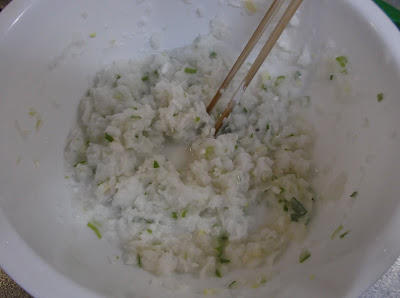In early October, I got a bag of dried enoki from a neighbor. I added some of it to miso soup, fried rice, and some other dishes. Yesterday, I decided to add the rest of it to kakiage.
I first microwaved it for 20 seconds or so to bring out the dried squid-like flavor.
10月初め、近所の人から干しえのきをもらいました。味噌汁やチャーハンなどに入れました。昨日は、残りをかき揚げに入れることにしました。
まず、電子レンジで20秒ほど加熱して、するめに似た風味を出しました。
Then, I added it to the carrot and onion.
次ににんじんと玉ねぎと混ぜました。
I first made gyoniku (fishmeat) tempura, followed by kabocha tempura and sweet potato tempura.
最初に魚肉ソーセージ天ぷら、次にかぼちゃの天ぷらとサツマイモの天ぷらを作りました。
The tempura batter was a little too thick for kakiage, so I added some water. When making kakiage, make sure you leave extra batter in the bowl when scooping up some of the ingredients (using a spoon, a slotted ladle, a pair of chopstick, or something similar) to put in the fryer, because no one wants to have heavy kakiage.
天ぷらの衣はかき揚げにはちょっと濃すぎたので、水を少し足しました。かき揚げを作る時は、鍋に入れる具を(スプーン、穴あきのお玉、箸などで)すくう際に余分な衣をボールに落とすようにします。重たいかき揚げを食べたい人はいないので。
I don't care about kakiage of varied shapes and sizes. If you do, use some kind of mold (used can, for example).
私自身はかき揚げが色々な形や大きさになっても気にしませんが、気にするなら、何らかの型(使い終わった缶詰の缶など)を使ってください。
A quarter of a carrot and a quarter of an onion result in this amount of kakiage.
にんじん1/4本と玉ねぎ1/4本でこれだけのかき揚げになります。
This is all the tempura I made last night. We had cold soba with it.
昨晩はこれだけ天ぷらを作りました。蕎麦と一緒に食べました。
Some of the leftover tempura will be frozen to be put in my son's bento.
残りの天ぷらの一部は冷凍して、息子の弁当に入れます。

















































